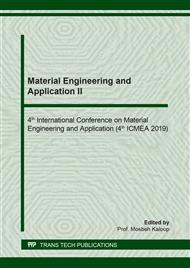[1]
N. R. Tao, Z. B. Wang, W. P. Tong, M. L. Sui, J. Lu, K. Lu, An investigation of surface nanocrystallization mechanism in Fe induced by surface mechanical attrition treatment, Acta Mater., 50 (2002) 4603-4616.
DOI: 10.1016/s1359-6454(02)00310-5
Google Scholar
[2]
M. Sato, N. Tsuji, Y. Minamino, Y. Koizumi, Formation of nanocrystalline surface layers in various metallic materials by near surface severe plastic deformation, Sci. Technol. Adv. Mater., 5 (2004) 145-152.
DOI: 10.1016/j.stam.2003.10.015
Google Scholar
[3]
X.Y. Wang, D.Y. Li, Mechanical, electrochemical and tribological properties of nano-crystalline surface of 304 stainless steel, Wear 255 (2003) 836-845.
DOI: 10.1016/s0043-1648(03)00055-3
Google Scholar
[4]
W. Yan, L. Fang, Z. Zheng, K. Sun, Y. Xu, Effect of surface nanocrystallization on abrasive wear properties in Hadfield steel, Tribology Int., 42 (2009) 634-641.
DOI: 10.1016/j.triboint.2008.08.012
Google Scholar
[5]
J.G. Li, M. Umemoto, Y. Todaka, K. Tsuchiya, A microstructural investigation of the surface of a drilled hole in carbon steels, Acta Mater., 55 (2007) 1397-1406.
DOI: 10.1016/j.actamat.2006.09.043
Google Scholar
[6]
C. Yin, Y. Liang, Y. Jiang, M. Yang, S. Long, Formation of nano-laminated structures in a dry sliding wear-induced layer under different wear mechanisms of 20CrNi2Mo steel, Appl. Surf. Sci., 423 (2017) 305-313.
DOI: 10.1016/j.apsusc.2017.06.187
Google Scholar
[7]
A. Amanov, I.S. Cho, Y.S. Pyoun, C.S. Lee, I.G. Park, Micro-dimpled surface by ultrasonic nanocrystal surface modification and its tribological effects, Wear, 286-287 (2012) 136-144.
DOI: 10.1016/j.wear.2011.06.001
Google Scholar
[8]
G. D. Revankar, R. Shetty, S.S. Rao, V.N. Gaitonde, Wear resistance enhancement of titanium alloy (Ti–6Al–4V) by ball burnishing process, J. Mater. Res. Tech., 6 (2017) 13-32.
DOI: 10.1016/j.jmrt.2016.03.007
Google Scholar
[9]
A. M. Hassan, A.S. Al-Bsharat, Influence of burnishing process on surface roughness, hardness, and microstructure of some non-ferrous metals, Wear, 199 (1996) 1-8.
DOI: 10.1016/0043-1648(95)06847-3
Google Scholar
[10]
M. Okada, S. Suenobu, K. Watanabe, Y. Yamashita, N. Asakawa, Development and burnishing characteristics of roller burnishing method with rolling and sliding effects, Mechatronics, 29 (2015) 110-118.
DOI: 10.1016/j.mechatronics.2014.11.002
Google Scholar
[11]
V. Chomienne, F. Valiorgue, J. Rech, C. Verdu, Influence of ball burnishing on residual stress profile of a 15-5PH stainless steel, CIRP J. Manuf. Sci. Tech., 13 (2016) 90-96.
DOI: 10.1016/j.cirpj.2015.12.003
Google Scholar
[12]
N.S.M. El-Tayeb, K.O. Low, P.V. Brevern, Influence of roller burnishing contact width and burnishing orientation on surface quality and tribological behaviour of Aluminium 6061, J. Mater. Process. Tech., 186 (2007) 272-278.
DOI: 10.1016/j.jmatprotec.2006.12.044
Google Scholar
[13]
A. Nestler, A. Schubert, Effect of Machining Parameters on Surface Properties in Slide Diamond Burnishing of Aluminium Matrix Composites, Materials Today, Proc. 2S (2015) S156-S161.
DOI: 10.1016/j.matpr.2015.05.033
Google Scholar
[14]
V.P. Kuznetsov, S.Y. Tarasov, A.I. Dmitriev, Nanostructuring burnishing and subsurface shear instability, J. Mater. Process. Tech., 217 (2015) 327-335.
DOI: 10.1016/j.jmatprotec.2014.11.023
Google Scholar
[15]
H.W. Huang, Z.B. Wang, J. Lu and K. Lu, Fatigue behaviors of AISI 316L stainless steel with a gradient nanostructured surface layer, Acta Mater., 87 (2015) 150-160.
DOI: 10.1016/j.actamat.2014.12.057
Google Scholar
[16]
W.L. Li N.R. Tao, Z. Han and K. Lu, Comparisons of dry sliding tribological behaviors between coarse-grained and nanocrystalline copper, Wear, 274-275 (2012) 306-312.
DOI: 10.1016/j.wear.2011.09.010
Google Scholar
[17]
A.M. Hassan and S.Z.S. Al-Dhifi, Improvement in the wear resistance of brass components by the ball burnishing process, J. Mater. Process. Tech., 96 (1999) 73-80.
DOI: 10.1016/s0924-0136(99)00254-x
Google Scholar


